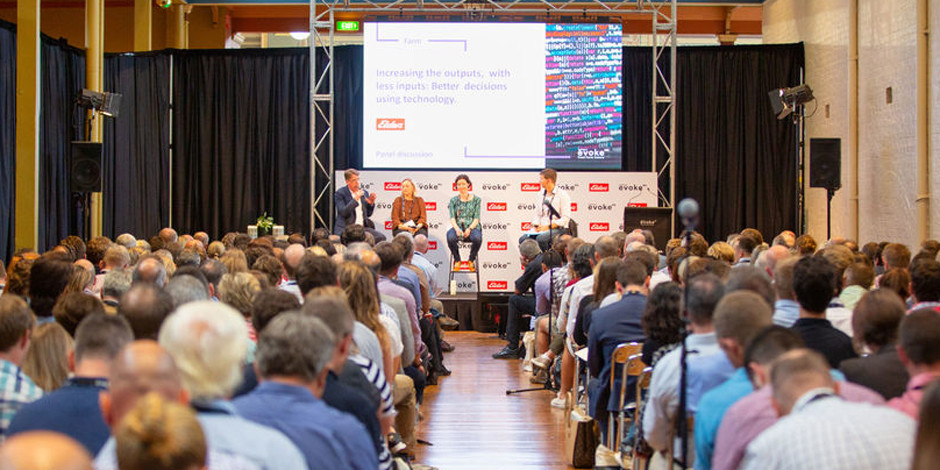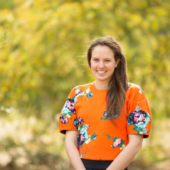The most popular Breakout Sessions at evokeAG. 2020
Two months on from evokeAG. the dust has settled, and the wheels are churning on the future program. This is an ideal time to reflect on the success of the two-day agrifood tech triumph. We have crunched the numbers from the sell-out event and found our three breakout sessions that drew the biggest crowds. Here's a wrap on the most popular Breakout Sessions at evokeAG. 2020

It’s no surprise that technology, data and on-farm adoption were key themes throughout the two day event. The top three breakouts all discussed similar topics, it was clear delegates wanted to know not ‘what’ technology to use but ‘how’ to decide when to invest in these innovative technologies, how to tackle the adoption barrier, how to use the data captured to make more informed decisions to improve productivity and how to work smarter not harder.
1. Increasing the outputs, with less inputs: Better decisions using technology
Day one at evokeAG. saw delegates flocking to the ‘Increasing the outputs, with less inputs’ session which was powered by Platinum Partner Elders. The panel shared insights into how data collected on-farm can be used to make educated decisions to minimise losses, improve productivity, increase yields, and how to make appropriate use of the valuable data to improve the whole farm decision making process.
The diverse panel of thought leaders included Research Scientist and Primary Producer Dr Kelly Pearce, Dairy Genetics and Genomics Specialist Dr Jennie Pryce, Aidan Connolly of Irish AI company Cainthus and facilitated by precision agriculture expert Darren Hughes of Laconik. The panel of leading industry experts also dived into cutting through the agtech hype to find products that will drive revenue for farmers.
Dr Pearce said farmers learn best from other farmers who have tried and tested these emerging technologies. The Western Australian grain and sheep producer noted there needs to be healthier systems in place where startups can ground truth and test bed their technologies in a more professional level. This ensures a better-demonstrated return on investment, resulting in rapid commercialisation, adoption, uptake and collaboration among multiple players along the ecosystem.
Genomics expert, Dr Pryce discussed the need for a greater need of capacity in the agricultural field; there’s a need for agricultural experts with also a high knowledge of programming. Dr Pryce said once we train the right people in this space, we will find gold, and is an exciting opportunity for people with those cross-sectoral skills to enter the agricultural space.
2. A farmers new best friend: AI and remote sensing technology that is taking the legwork out of farming
How does technology make a farmers life easier? This topic drew a big crowd on day one at evokeAG. with delegates keen to hear from leading industry experts on the AI and remote sensing technology they’re using on-farm and what challenges they pose.
Virtual fencing startup founder, Ian Reilly of Agersens said the expectation from farmers is that in the next fifty years virtual fencing and remote sensors will be commonplace on farms, a necessity to maximise productivity. But first, the challenge of adoption needs to be tackled.
Viticulturist, Andy Clarke of GAIA Innovations noted barriers are only put in place against adoption, if the consumer doesn’t understand the technology. Getting consumers to understand the benefits the technology can provide is only the first step, consumers need to understand how to approach the technology and how to put it into practice but Mr Clarke stated that the generational change that is currently evolving will aid in adopting emerging technologies.
When facilitator Tom Raynor of Myriota posed the question of how Australia is perceived as an agtech country overseas? The panel agreed that Australia is seen at being at the forefront of agriculture and therefore has an opportunity to market agtech well overseas.
Darryn Keiller, CEO of Autogrow sees an opportunity for entrepreneurs to transfer the deeply held research and intellectual property currently being held in Universities, into the market and onto farms. Mr Clark agreed and said commercialisation is one of the biggest missing steps in getting new technologies into the market. The solution? We need to be more innovative in our approach.
3. Producer led innovation: The stories of farmer using innovation every day
Coming in at the third most popular breakout of evokeAG. 2020, was the ‘Producer led innovation’ session powered by the Western Australian Department of Primary Industries Research and Development. A reoccurring statement through various breakout sessions was that farmers learn and adopt technology that other farmers are using, so this session was a great way for delegates to hear stories from a panellist of producers. The producer driven panel was facilitated by food systems innovation expert Sarah Nolet of AgThentic and was formed of Brad Jones of Bungulla Farms, Sue Middleton of Agdots and Mark Mortimer of Centre Plus, all of which are at the forefront of farming innovation using agtech in various forms on their farming enterprises. The panel discussed the challenges and opportunities that agtech has provided and how it has become a vital part of their business.
The topic of agtech adoption was certainly a hot one, the session touched on the producers’ perspective of how to decide if they should use a product on farm. Mr Jones noted the obstacle associated with adoption is confidence. Farmers need to have confidence in what they’re trying to achieve and for startups it’s offering support in various forms, both face-to-face and remote, to those farmers.
For Mr Mortimer, the answer was core business; it’s easy to sell him technology that will make his job easier. The technology has to be helping to eliminate labour, and not creating a farmer more work. The magic moment is when the data captured by a product is a bi-product of farm management.
Sue Middleton said the biggest selling point for her when adopting new technologies is hearing first hand from other farmers what they’re using, what worked and what hasn’t. Ms Middleton encouraged farmers to be proactive and welcoming those new conversations with startups about their technology, and not be passive when it comes to agtech.
Enjoyed this story? Want to learn more about the Asia Pacific region’s innovative agrifood tech ecosystem? Sign up for our newsletter here and receive fresh stories about global leaders, farmers, startups and innovators driving collaborative change.
